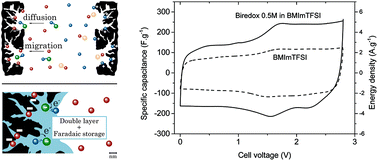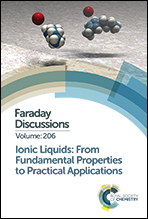Biredox ionic liquids: new opportunities toward high performance supercapacitors
Abstract
Nowadays commercial supercapacitors are based on purely capacitive storage at the porous carbons that are used for the electrodes. However, the limits that capacitive storage imposes on energy density calls to investigate new materials to improve the capacitance of the device. This new type of electrodes (e.g., RuO2, MnO2…) involves pseudo-capacitive faradaic redox processes with the solid material. Ion exchange with solid materials is, however, much slower than the adsorption process in capacitive storage and inevitably leads to significant loss of power. Faradaic process in the liquid state, in contrast can be similarly fast as capacitive processes due to the fast ion transport. Designing new devices with liquid like dynamics and improved specific capacitance is challenging. We present a new approach to increase the specific capacitance using biredox ionic liquids, where redox moieties are tethered to the electrolyte ions, allowing high redox concentrations and significant pseudo-capacitive storage in the liquid state. Anions and cations are functionalized with anthraquinone (AQ) and 2,2,6,6-tetramethylpiperidinyl-1-oxyl (TEMPO) moieties, respectively. Glassy carbon, carbon-onion, and commercial activated carbon electrodes that exhibit different double layer structures and thus different diffusion dynamics were used to simultaneously study the electrochemical response of biredox ionic liquids at the positive and negative electrode.

- This article is part of the themed collection: Ionic liquids: from fundamental properties to practical applications


 Please wait while we load your content...
Please wait while we load your content...